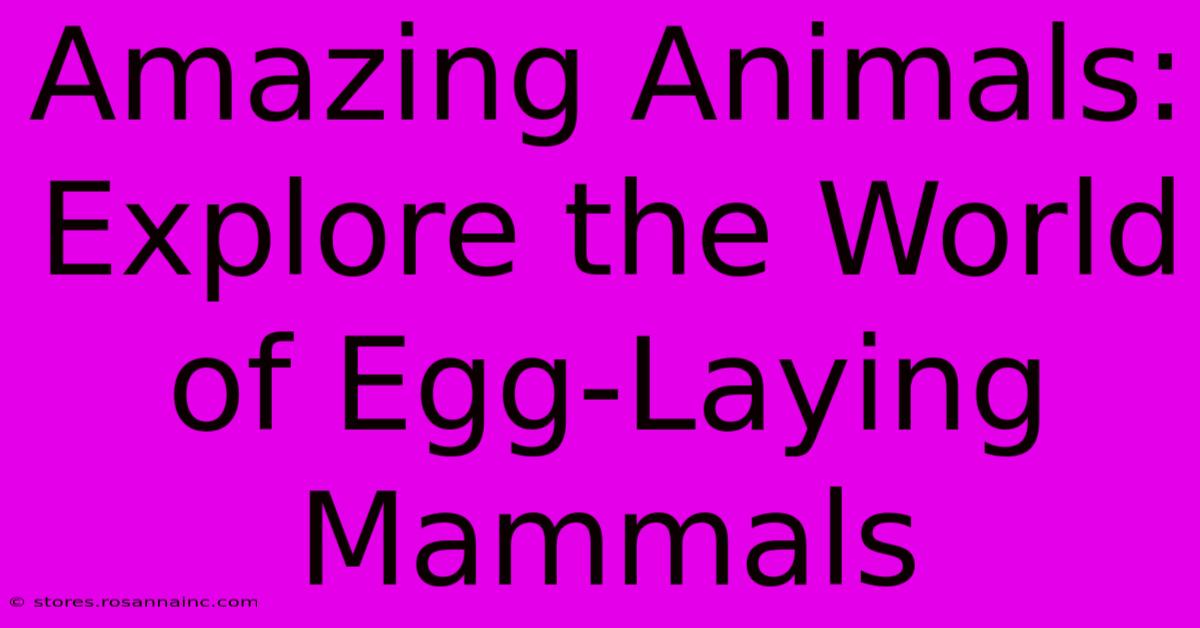Amazing Animals: Explore The World Of Egg-Laying Mammals

Table of Contents
Amazing Animals: Explore the World of Egg-Laying Mammals
The animal kingdom is a vast and wondrous place, teeming with creatures of all shapes and sizes. Among the most fascinating are the monotremes – the only mammals that lay eggs. These unique animals represent a crucial evolutionary link, bridging the gap between reptiles and mammals. Let's delve into the amazing world of these egg-laying marvels!
What are Monotremes?
Monotremes are a group of primitive mammals found only in Australia and New Guinea. Unlike other mammals, they reproduce by laying eggs, a characteristic more commonly associated with reptiles and birds. This distinct reproductive strategy sets them apart and makes them a captivating subject of study for zoologists and evolutionary biologists alike. The three existing species are the echidnas (short-beaked and long-beaked) and the platypus.
Key Characteristics of Monotremes:
- Egg-laying: As mentioned, the most defining characteristic is their oviparity – laying eggs instead of giving birth to live young.
- Cloaca: Monotremes possess a cloaca, a single opening for the urinary, reproductive, and digestive tracts. This feature is also found in reptiles, birds, and amphibians.
- Electroreception: The platypus boasts an exceptional adaptation: electroreception. It uses specialized receptors in its bill to detect the weak electrical fields generated by the muscle contractions of its prey.
- Low Metabolic Rate: Compared to other mammals, monotremes have a relatively low metabolic rate.
- Spur: Male echidnas and platypuses possess a spur on their hind legs, which, in the platypus, is connected to a venom gland.
The Platypus: A Paradoxical Wonder
The platypus (Ornithorhynchus anatinus) is arguably the most famous monotreme. Its unusual combination of features – a duck-like bill, otter-like body, and beaver-like tail – makes it seem almost mythical. This semi-aquatic mammal is perfectly adapted to its environment, hunting for insect larvae and crustaceans in rivers and streams. Its waterproof fur, webbed feet, and electroreception skills make it a highly efficient predator.
Platypus Reproduction: A Fascinating Process
Female platypuses lay one to three leathery eggs in a burrow. The eggs are incubated for around 10 days, and the young, called puggles, are nourished by their mother's milk. Interestingly, platypuses lack nipples; the milk is secreted through pores on the mother's skin.
Echidnas: The Spiny Anteaters
Echidnas (Tachyglossidae) are another fascinating group of monotremes. These insectivores are covered in spines, providing excellent protection against predators. They have long, sticky tongues used to capture ants and termites, their primary food source. Short-beaked echidnas are more common and widespread than their long-beaked counterparts.
Echidna Reproduction: A Solitary Affair
Echidnas are also egg-laying mammals. The female lays a single leathery egg, which she incubates in a pouch on her belly. The puggle remains in the pouch for several months, feeding on the mother's milk until it develops its spines and is able to forage independently.
Conservation Status and Threats
While not all monotremes are currently endangered, they face various threats, including habitat loss due to deforestation and urbanization, introduced predators, and climate change. Conservation efforts are crucial to ensure the survival of these unique and extraordinary creatures. Supporting organizations dedicated to wildlife conservation and advocating for responsible land management are vital steps in protecting these remarkable animals for future generations.
Conclusion: The Importance of Monotremes
The egg-laying mammals represent a significant piece of the evolutionary puzzle. Their existence highlights the incredible diversity and adaptability of life on Earth. Understanding and protecting these amazing animals is essential not only for their survival but also for our understanding of the intricate web of life that connects us all. Further research and conservation efforts are vital to ensuring these enigmatic creatures continue to thrive in their natural habitats.

Thank you for visiting our website wich cover about Amazing Animals: Explore The World Of Egg-Laying Mammals. We hope the information provided has been useful to you. Feel free to contact us if you have any questions or need further assistance. See you next time and dont miss to bookmark.
Featured Posts
-
Pmi A Powerful Tool For Uncovering Hidden Relationships
Feb 11, 2025
-
Doncics All Star La Debut
Feb 11, 2025
-
Minnesota Vs Tampa Bay Crucial Match Stats You Need To Know
Feb 11, 2025
-
Lamar Drake Feud Super Bowl Origins
Feb 11, 2025
-
Yeezy Brands Swastika Shirt Sales
Feb 11, 2025
